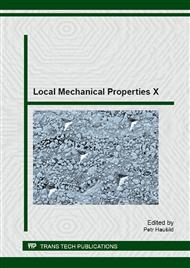[1]
J. Menčík and M.V. Swain, Micro-Indentation Tests with Pointed Indenters. Materials Forum 18 (1994) 277-288.
Google Scholar
[2]
J. Malzbender, Comment on the determination of mechanical properties from the energy dissipated during indentation. J. Mater. Res., Vol. 20, No. 5 (2005) 1090-1092.
DOI: 10.1557/jmr.2005.0162
Google Scholar
[3]
Y-T. Cheng and C-M. Cheng, Relationship between hardness, elastic modulus and work of indentation. Appl. Phys. Lett. 73 (1998) No. 5, 614-616.
DOI: 10.1063/1.121873
Google Scholar
[4]
M. Sakai, Energy principle of the indentation-induced inelastic surface deformation and hardness of brittle materials. Acta metall. mater. Vol. 41 (1993) 1751-1758.
DOI: 10.1016/0956-7151(93)90194-w
Google Scholar
[5]
L-H. He and M.V. Swain, Energy absorption characterization of human enamel using nanoindentation. J. Biomed. Mater. Res. Part A (2006) 484-492.
DOI: 10.1002/jbm.a.31051
Google Scholar
[6]
B. Rother and D. Dietrich, Differential Load Feed Analysis: An Energy Related Alternative to the Interpretation of Hardness Indentation Measurements. phys. stat. sol. (a) 142 (1994) 389-407.
DOI: 10.1002/pssa.2211420212
Google Scholar
[7]
J. Malzbender and G. de With, Energy dissipation, fracture toughness and the indentation load-displacement curve of coated materials. Surf. Coat. Technol. 135 (2000) 60-68.
DOI: 10.1016/s0257-8972(00)00906-3
Google Scholar
[8]
B.R. Lawn, A.G. Evans and D.B. Marshall, Elastic/plastic indentation damage in ceramics: the median/radial crack system. J. Am. Ceram. Soc. 63 (1980) 574-581.
DOI: 10.1111/j.1151-2916.1980.tb10768.x
Google Scholar
[9]
J.N. Israelachvili, Intermolecular and surface forces, 2nd ed., Academic Press, London, (1992).
Google Scholar
[10]
J. Menčík, Low-load nanoindentation: influence of surface forces and adhesion. Chem. Listy 106 (2012) s481-s484.
Google Scholar
[11]
J. Menčík, Uncertainties and Errors in Nanoindentation, Chapter 3 in J. Němeček (editor), Nanoindentation in Materials Science, InTech, Rijeka, 2012, pp.53-86. (Open Access).
Google Scholar


